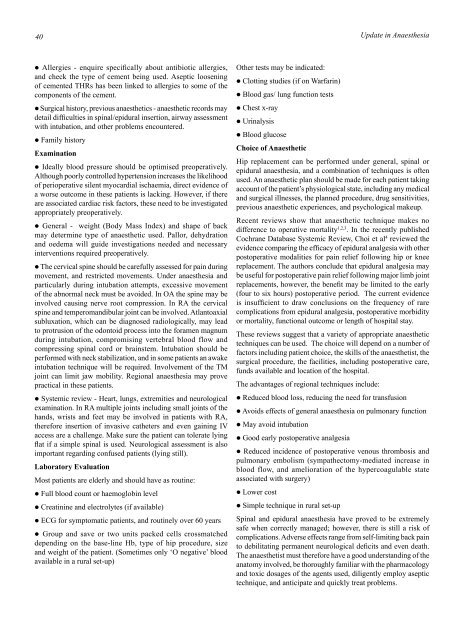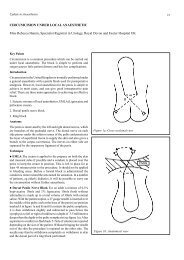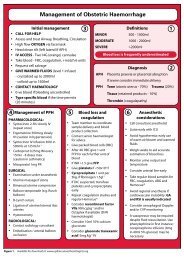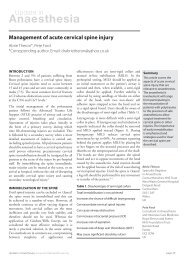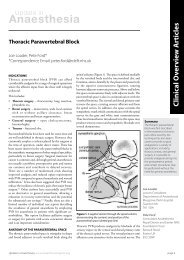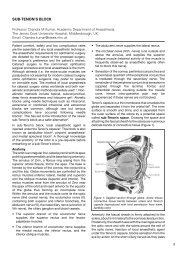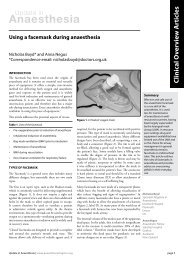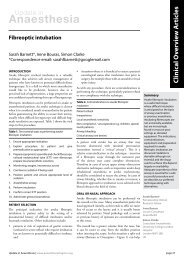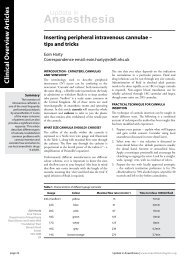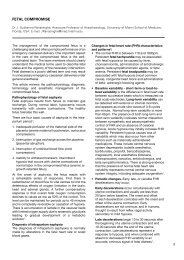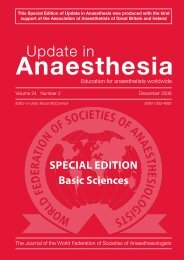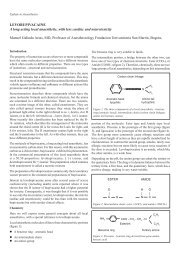Anaesthesia For Hip Replacement - Update in Anaesthesia
Anaesthesia For Hip Replacement - Update in Anaesthesia
Anaesthesia For Hip Replacement - Update in Anaesthesia
Create successful ePaper yourself
Turn your PDF publications into a flip-book with our unique Google optimized e-Paper software.
40<br />
l Allergies - enquire specifically about antibiotic allergies,<br />
and check the type of cement be<strong>in</strong>g used. Aseptic loosen<strong>in</strong>g<br />
of cemented THRs has been l<strong>in</strong>ked to allergies to some of the<br />
components of the cement.<br />
l Surgical history, previous anaesthetics - anaesthetic records may<br />
detail difficulties <strong>in</strong> sp<strong>in</strong>al/epidural <strong>in</strong>sertion, airway assessment<br />
with <strong>in</strong>tubation, and other problems encountered.<br />
l Family history<br />
Exam<strong>in</strong>ation<br />
l Ideally blood pressure should be optimised preoperatively.<br />
Although poorly controlled hypertension <strong>in</strong>creases the likelihood<br />
of perioperative silent myocardial ischaemia, direct evidence of<br />
a worse outcome <strong>in</strong> these patients is lack<strong>in</strong>g. However, if there<br />
are associated cardiac risk factors, these need to be <strong>in</strong>vestigated<br />
appropriately preoperatively.<br />
l General - weight (Body Mass Index) and shape of back<br />
may determ<strong>in</strong>e type of anaesthetic used. Pallor, dehydration<br />
and oedema will guide <strong>in</strong>vestigations needed and necessary<br />
<strong>in</strong>terventions required preoperatively.<br />
l The cervical sp<strong>in</strong>e should be carefully assessed for pa<strong>in</strong> dur<strong>in</strong>g<br />
movement, and restricted movements. Under anaesthesia and<br />
particularly dur<strong>in</strong>g <strong>in</strong>tubation attempts, excessive movement<br />
of the abnormal neck must be avoided. In OA the sp<strong>in</strong>e may be<br />
<strong>in</strong>volved caus<strong>in</strong>g nerve root compression. In RA the cervical<br />
sp<strong>in</strong>e and temperomandibular jo<strong>in</strong>t can be <strong>in</strong>volved. Atlantoaxial<br />
subluxation, which can be diagnosed radiologically, may lead<br />
to protrusion of the odontoid process <strong>in</strong>to the foramen magnum<br />
dur<strong>in</strong>g <strong>in</strong>tubation, compromis<strong>in</strong>g vertebral blood flow and<br />
compress<strong>in</strong>g sp<strong>in</strong>al cord or bra<strong>in</strong>stem. Intubation should be<br />
performed with neck stabilization, and <strong>in</strong> some patients an awake<br />
<strong>in</strong>tubation technique will be required. Involvement of the TM<br />
jo<strong>in</strong>t can limit jaw mobility. Regional anaesthesia may prove<br />
practical <strong>in</strong> these patients.<br />
l Systemic review - Heart, lungs, extremities and neurological<br />
exam<strong>in</strong>ation. In RA multiple jo<strong>in</strong>ts <strong>in</strong>clud<strong>in</strong>g small jo<strong>in</strong>ts of the<br />
hands, wrists and feet may be <strong>in</strong>volved <strong>in</strong> patients with RA,<br />
therefore <strong>in</strong>sertion of <strong>in</strong>vasive catheters and even ga<strong>in</strong><strong>in</strong>g IV<br />
access are a challenge. Make sure the patient can tolerate ly<strong>in</strong>g<br />
flat if a simple sp<strong>in</strong>al is used. Neurological assessment is also<br />
important regard<strong>in</strong>g confused patients (ly<strong>in</strong>g still).<br />
Laboratory Evaluation<br />
Most patients are elderly and should have as rout<strong>in</strong>e:<br />
l Full blood count or haemoglob<strong>in</strong> level<br />
l Creat<strong>in</strong><strong>in</strong>e and electrolytes (if available)<br />
l ECG for symptomatic patients, and rout<strong>in</strong>ely over 60 years<br />
l Group and save or two units packed cells crossmatched<br />
depend<strong>in</strong>g on the base-l<strong>in</strong>e Hb, type of hip procedure, size<br />
and weight of the patient. (Sometimes only ‘O negative’ blood<br />
available <strong>in</strong> a rural set-up)<br />
Other tests may be <strong>in</strong>dicated:<br />
l Clott<strong>in</strong>g studies (if on Warfar<strong>in</strong>)<br />
l Blood gas/ lung function tests<br />
l Chest x-ray<br />
l Ur<strong>in</strong>alysis<br />
l Blood glucose<br />
Choice of Anaesthetic<br />
<strong>Update</strong> <strong>in</strong> <strong>Anaesthesia</strong><br />
<strong>Hip</strong> replacement can be performed under general, sp<strong>in</strong>al or<br />
epidural anaesthesia, and a comb<strong>in</strong>ation of techniques is often<br />
used. An anaesthetic plan should be made for each patient tak<strong>in</strong>g<br />
account of the patient’s physiological state, <strong>in</strong>clud<strong>in</strong>g any medical<br />
and surgical illnesses, the planned procedure, drug sensitivities,<br />
previous anaesthetic experiences, and psychological makeup.<br />
Recent reviews show that anaesthetic technique makes no<br />
difference to operative mortality 1,2,3 . In the recently published<br />
Cochrane Database Systemic Review, Choi et al 4 reviewed the<br />
evidence compar<strong>in</strong>g the efficacy of epidural analgesia with other<br />
postoperative modalities for pa<strong>in</strong> relief follow<strong>in</strong>g hip or knee<br />
replacement. The authors conclude that epidural analgesia may<br />
be useful for postoperative pa<strong>in</strong> relief follow<strong>in</strong>g major limb jo<strong>in</strong>t<br />
replacements, however, the benefit may be limited to the early<br />
(four to six hours) postoperative period. The current evidence<br />
is <strong>in</strong>sufficient to draw conclusions on the frequency of rare<br />
complications from epidural analgesia, postoperative morbidity<br />
or mortality, functional outcome or length of hospital stay.<br />
These reviews suggest that a variety of appropriate anaesthetic<br />
techniques can be used. The choice will depend on a number of<br />
factors <strong>in</strong>clud<strong>in</strong>g patient choice, the skills of the anaesthetist, the<br />
surgical procedure, the facilities, <strong>in</strong>clud<strong>in</strong>g postoperative care,<br />
funds available and location of the hospital.<br />
The advantages of regional techniques <strong>in</strong>clude:<br />
l Reduced blood loss, reduc<strong>in</strong>g the need for transfusion<br />
l Avoids effects of general anaesthesia on pulmonary function<br />
l May avoid <strong>in</strong>tubation<br />
l Good early postoperative analgesia<br />
l Reduced <strong>in</strong>cidence of postoperative venous thrombosis and<br />
pulmonary embolism (sympathectomy-mediated <strong>in</strong>crease <strong>in</strong><br />
blood flow, and amelioration of the hypercoagulable state<br />
associated with surgery)<br />
l Lower cost<br />
l Simple technique <strong>in</strong> rural set-up<br />
Sp<strong>in</strong>al and epidural anaesthesia have proved to be extremely<br />
safe when correctly managed; however, there is still a risk of<br />
complications. Adverse effects range from self-limit<strong>in</strong>g back pa<strong>in</strong><br />
to debilitat<strong>in</strong>g permanent neurological deficits and even death.<br />
The anaesthetist must therefore have a good understand<strong>in</strong>g of the<br />
anatomy <strong>in</strong>volved, be thoroughly familiar with the pharmacology<br />
and toxic dosages of the agents used, diligently employ aseptic<br />
technique, and anticipate and quickly treat problems.


